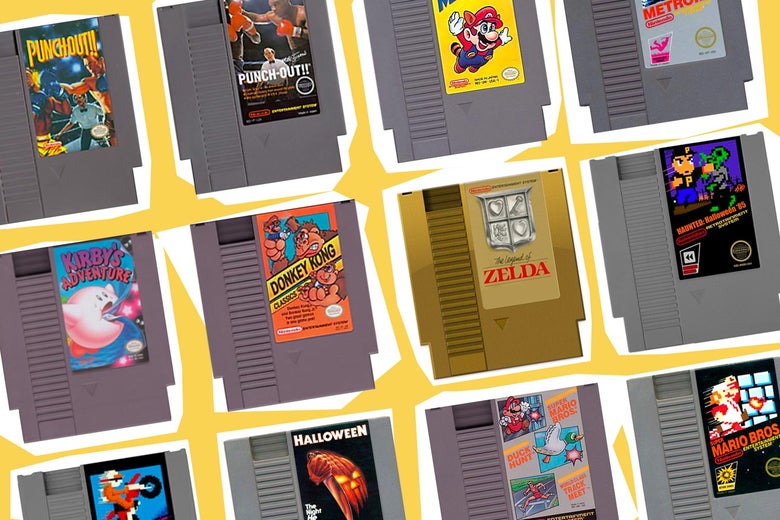
Sunday will mark 35 years since the Nintendo Entertainment System arrived on America’s shores, saving a crashed video game industry and making a generation of gamers out of people who first learned to “play Nintendo” on the NES.
People such as me. For this 35-year-old, it’s striking how Nintendo’s breakout home game system, which my parents bought for my older brothers and which I literally grew up with, remains not only the bedrock of the company’s corporate identity—witness the 8-bit Mario on your browser tab if you visit the Big N’s website—but its creative wellspring too. Witness how Super Mario Bros. 35, Nintendo’s new contender in the über-popular battle royal genre, is a thin remix of 1985’s Super Mario Bros., an NES launch title. Or see the NES Classic, the recent bestselling miniversion of the console with 30 games packed in. While very few people may have the original gray-on-gray NES hooked up to their TV anymore, the titles designed for it will remain relevant for Nintendo fans of all ages as long as the company stays in the game.
Proof of the NES’s continued importance to Nintendo is the library of 55 (and counting) NES games that the company offers to the 26 million subscribers to Nintendo Switch Online. For $20 a year, you can get a Nintendo membership that unlocks online features for its latest hit console, the Switch, plus this library of retro titles. The Switch lets you suspend NES games, putting them down to return to later, as well as rewind your progress to undo mistakes like running Mario into a pit. These features are a mixed blessing, as they allow gamers of a certain age to finally conquer white whales like Mario 2, while hollowing other games of much of their challenge, like Kirby’s Adventure.
Herewith, a ranking of all 55 games. Note: Though we’re rewinding to the ’80s and ’90s, this isn’t a ranking of the games’ greatness or influence, but of how well they play today. Part of the enduring appeal of these games is in their pick-up-and-play nature, compared with the sprawling, sometimes intimidating big-budget titles of today. And in the NES era, Ingenious Nintendo and Just Plain Weird Nintendo were shining as brightly as ever, wringing delights and oddities from a modest 8-bit system. Granted, some were more successful than others …
55. Mighty Bomb Jack (Tecmo, 1987): You’d have to be mighty bombed on Jack for this game to make sense. Your goal is to collect bombs while avoiding enemies, but you aren’t allowed to use them to, say, defeat any of the dumb mummies and birds constantly killing you. It’s like if the object of Doom were to collect shotguns you weren’t allowed to fire. The only way to defeat enemies is with power-ups that turn them into coins. Collect more than nine coins in a level, though, and the screen flashes: “YOU ARE GREEDY. GO TO THE TORTURE ROOM.” You are then trapped in a sin bin with even more dumb mummies and birds. I wish I were making this up.
54. Wrecking Crew (Nintendo, 1985): The worst of the NES’s launch titles, Wrecking Crew stars a Mario stripped of his signature move, jumping. Instead, the earthbound plumber is cast as a demolition guy, but he’s not allowed to use his hammer to beat back the enemies chasing him. The object of the game is to destroy things in the right order; break a ladder too soon, say, and you’ll lose access to other things you have to break to clear the level, and you’ll have no choice but to reset the game. Um, yay!
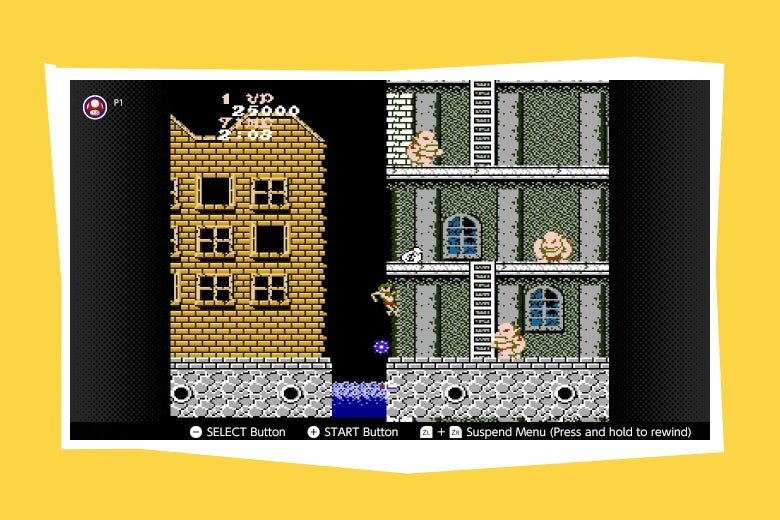
Photo illustration by Slate. Photo by Capcom.
53. Ghosts ‘n Goblins (Capcom, 1986): Gamers look back on Ghosts ‘n Goblins fondly for funny quirks—protagonist Sir Arthur goes from wearing a full suit of armor to just boxers upon taking damage—but it is unplayably difficult. If you beat the game once, an unimaginable prospect even with the Switch’s rewind feature, you have to then beat it again on a higher difficulty setting to face the true boss. Are they kidding?
52. The Immortal (Electronic Arts, 1990): I’ve heard of dark fantasy, but this is ridiculous! This isometric action-adventure has you facing off with pitch-black enemies, against a black background, in battles that are presented as RPG-ish but are actually pure button-mashing. Between fights, you memorize floor layouts so your character doesn’t fall into instant-death trapdoors, a marquee mechanic in the school of fun avoidance.
51. Tennis (Nintendo, 1985): So close to Wii Sports but so, so far. This might be the only unfun tennis video game.
50. Kung-Fu Heroes (Culture Brain, 1989): Skirting the edge of copyright infringement, this beat-’em-up game plays the 1-up sound from Mario when you punch blocks, and a power-up lets you throw bouncing fireballs just like a certain super someone. Kung-Fu Heroes gets novelty points for being top-down instead of a side-scroller like its genre brethren, but no other game burns through five lives so fast: A single hit will cost you your life.
49. Gradius (Konami, 1986): I timed it. Less than two minutes into this good-looking shoot ’em up, there is a sequence I can’t get past no matter how many times I rewind and try again. Please, Konami, give us Gradius spinoff Life Force, which had both side- and vertical-scrolling, and some of the freakiest, most fascinating bosses in the NES canon.
48. Journey to Silius (Sunsoft, 1990): This game copies sound and even visual effects from its big brother Blaster Master, but unfortunately, Sunsoft didn’t graft gameplay elements as well. Instead, we get a poor man’s Contra full of bullet-spraying enemies that would be better suited to a shoot ’em up than a run and gun.
47. Soccer (Nintendo, 1985): Just as bad as the real thing.
46. Clu Clu Land (Nintendo, 1985): I don’t have a clu how to land a victory in Clu Clu Land. It is by appearances Pac-Man-like, except with a control scheme that has you press up, down, left, and right not to immediately go in those directions but to stick out your little crab character’s claw to grab poles around which he swivels to head somewhere different. Somewhere different than you probably intended.
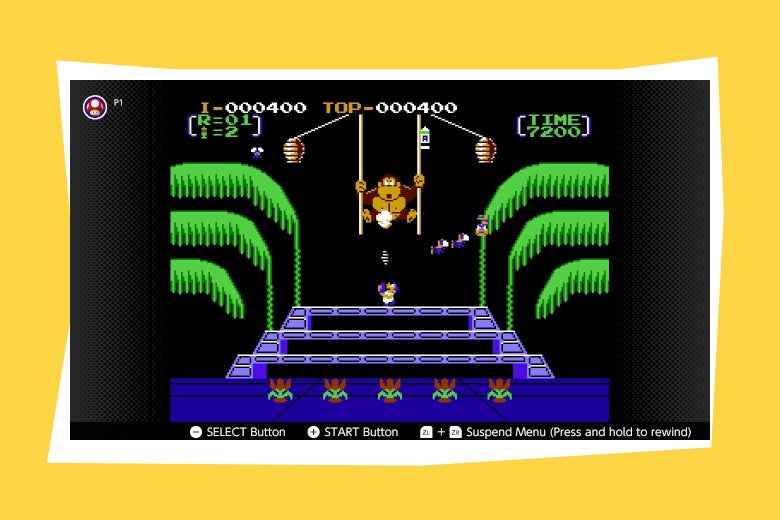
Photo illustration by Slate. Photo by Nintendo.
45. Donkey Kong 3 (Nintendo, 1986): The original Donkey Kong introduced the world to Mario (yes, yes, then known as Jumpman). Donkey Kong 3 introduces the world to the classic video game character … Stanley. Stanley is a gardener/exterminator/someone who tries to rid his greenhouse of Donkey Kong by blasting the great ape’s hindquarters with bug spray, like the world’s worst bidet. This task is complicated by waves of bees you also have to spray. The resulting gameplay is somewhere between Galaxian and Missile Command, and worse than either.
44. Super Dodge Ball (Technos Japan, 1989): From the team that would a year later bring us the excellent River City Ransom, Super Dodge Ball’s glitchy graphics and repetitive gameplay make one cry out for Switch versions of this company’s far superior sports game offerings, like Nintendo World Cup and Super Spike V’Ball.
43. Wario’s Woods (Nintendo, 1994): The final licensed NES title in North America is the Mario 2 of puzzle games: You control not falling blocks but a little guy, Toad, who is running around inside the play area picking up stacks of fallen blocks and tossing them onto other columns. Wario’s Woods has confusing mechanics and is almost impossible to lose. It’s a bad combination.
42. Ice Climber (Nintendo, 1985): Seemingly a product of the same acid trip that inspired Mario Bros. Where that game envisions a sewer as a fireball palace where you fight turtles, this one envisions a mountain as a place where you steal an eggplant belonging to a condor that looks more like a pterodactyl. If you don’t collect enough eggplants, or weird red carrots, or heads of lettuce complete with eyes, your ice climber cries loud and long. You will, too, when trying to muster any of the horizontal momentum necessary to jump onto the moving platforms.
41. Kid Icarus (Nintendo, 1987): A cross between Metroid and Ice Climber, this Greek mythology–inspired action platformer is marked by cupidity for draining winged protagonist Pit’s life. The stirring music greatly elevates the ultrahard proceedings and is the only apparent explanation for why this is a cult classic.
40. Adventures of Lolo (HAL Laboratory, 1989): The level designs in this puzzler can be clever, but ultimately this is a game of trial and error, and even the best of that type—like the circa-2000 Commandos games—require players to work an algorithm more than play a game, and thus are only so fun.
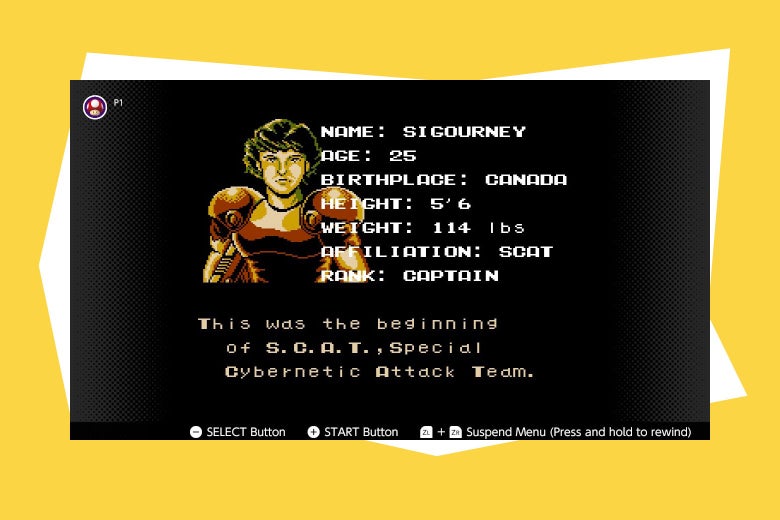
Photo illustration by Slate. Photo by Natsume.
39. S.C.A.T.: Special Cybernetic Attack Team (Natsume, 1991): Does a bear scat in the woods? Does S.C.A.T. star Arnold Schwarzenegger and Sigourney Weaver doppelgängers named, wait for it, Arnold and Sigourney? Yes and yes. This side-scrolling shooter plays a lot like Contra, except the guns are less distinctive, the stages are less varied, and your characters can fly. Apart from some great pixel art, cementing that airship levels are the best, there’s not much to see here.
38. Yoshi (Game Freak, 1991): It’s so satisfying to execute a just-in-the-nick-of-time maneuver in this column-swapping puzzler, which has you controlling not falling blocks but the landscape they fall on. The B Type mode, in which you clear the playing field of blocks in discrete levels, is superior to the interminable, I mean indefinite, play of the A Type.
37. Rygar (Tecmo, 1987): This ambitious action-adventure features an overworld in addition to its side-scrolling levels. But that doesn’t actually make navigating its world any easier, as you have to memorize layouts both within and between levels. The game’s grappling hook is a treat to use, and there are infinite continues—protagonist Rygar starts dead, so you can’t really kill him—meaning you can plausibly beat the game. You just might not want to.
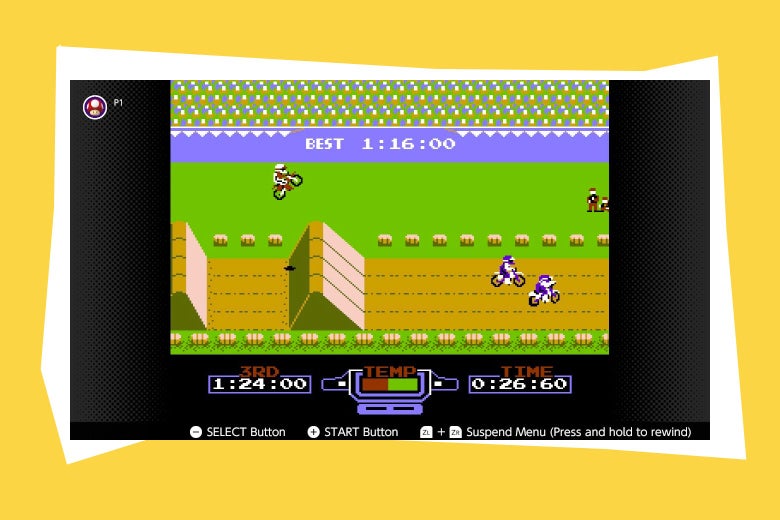
Photo illustration by Slate. Photo by Nintendo.
36. Excitebike (Nintendo, 1985): Gratuitously popping wheelies is the only excitement to be had on this bike. Play the Vs. version, also included in this library, instead.
35. Mario Bros. (Nintendo, 1986): Like in Ice Climber, the jumping in Mario Bros., designed for arcades in 1983, is extremely vertical. That is, it’s hard to get any momentum left or right, and you sure as hell can’t change directions midjump like in later games. The underlying formula here is solid—it’s still fun!—but the language of video game jumping fundamentally changed even between Mario Bros. and Super Mario Bros., and it’s hard to go back to Old English.
34. Double Dragon II: The Revenge (Technos Japan, 1990): This game features graffiti that says, “Go for broak.” The developers went for broak by changing the button mapping so that instead of A being punch and B being kick, A attacks to the right and B attacks to the left, no matter which way you’re facing. This bizarre design incentivizes you to face away from bad guys and do a weird reverse kick, because that move seems to have a longer reach than punching someone you’re facing. If you’re ever cornered by a gang that then turns away from you and starts donkey kicking, they were raised on Double Dragon II.
33. Donkey Kong Jr. (Nintendo, 1986): The only game I can think of whose object is to kill Mario. (If you win, he dies; he gets a halo!) Mario, presumably having saved Pauline from Donkey Kong in the first game, has put DK in a cage, and as Donkey Kong Jr. you have to climb alligator-laden vines to rescue dear old Dad. The game gets bonus points for having four stages instead of the original’s three, but negative bonus points for being easily the hardest of the NES’s DK trilogy.
32. Super Mario Bros.: The Lost Levels (Nintendo, 1986): Like the superhard version of Super Mario Bros.’ Level 1-1 that went viral in 2019, The Lost Levels is a nightmare mirror held up to Mario 1. Mushrooms make you smaller. Warp pipes take you backward. Jellyfish swim through the air. And jumping requires pixel-perfect precision that caused Nintendo honchos to fear the difficulty was too much for Western audiences. They were right.
31. Vice: Project Doom (American Sammy, 1991): This interesting little chimera is half Spy Hunter clone (in which, hilariously, defeated vehicles transform into hunks of meat that restore your car’s life) and half Ninja Gaiden clone, with cut scenes that rival Ninja Gaiden’s, beautiful backgrounds, and one of the more fun-to-use grenades on the NES. Too bad the game gets so hard so fast.
30. TwinBee (Konami, 1986): The real fun to be had in this culinary-themed shoot ’em up, in which some enemy planes look like knives and forks, isn’t in blasting the baddies but in bobbling bonus bells. The longer you keep them in the air, with well-timed shots between contending with enemies, the greater the upgrade they eventually confer to your ship.
29. Crystalis (SNK, 1990): Centered around a doomsday in 1997 (just like 1991’s Terminator 2), this Zelda-like game has excellent music and endearing towns, and even has your character playing an ocarina that the game calls an “alarm flute,” presaging the Nintendo 64’s Legend of Zelda: Alarm Flute of Time. Unlike in Zelda, killing enemies rewards you with not only money but experience points, lending a certain gestalt to all your little skirmishes. But the game launders this good idea into a bad one by making many enemies invulnerable unless your character has reached a certain level. Arbitrary gatekeeping, in games as in life, is no fun.
28. Baseball (Nintendo, 1985): I actually tied, 10 to 10, in my outing (so to speak!) with Baseball, meaning it’s the easiest of the Switch’s NES sports games. It’s enjoyable, in a meditative sort of way, but feints toward realism—all that pitcher head-shaking and attempted throw-outs of base runners (which succeed zero percent of the time) are a waste of precious player hours and make the relative lack of music glaring.
27. Eliminator Boat Duel (Electro Brain, 1991): Race boats against a Jerry Garcia lookalike named Aquarius Rex, while bikini babes with head-size breasts look on. There’s a nice sense of progression—you can spend race winnings (and losings) on upgrades like a faster engine and increased hull strength, reminiscent of the later Road Rash titles—but Eliminator Boat Duel short-circuits its good ideas by giving you a game over after two race losses.
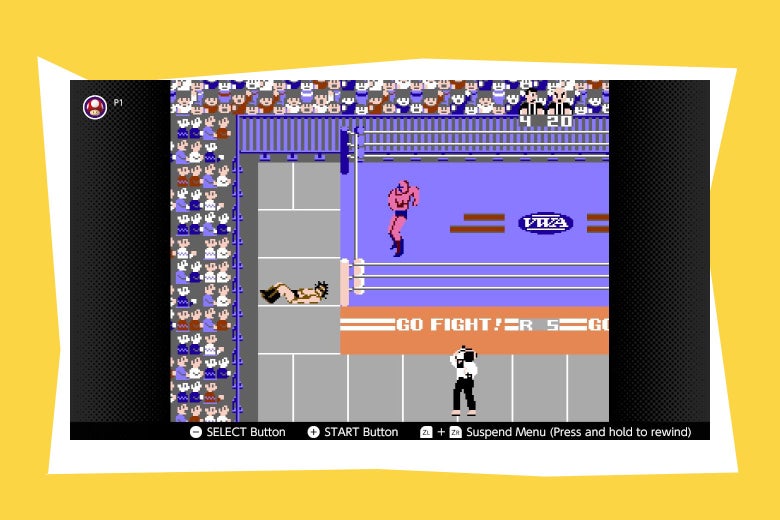
Photo illustration by Slate. Photo by Nintendo.
26. Pro Wrestling (Nintendo, 1987): More than twice as fun with two players, Pro Wrestling is hilarious when you and a friend are grappling with pulling off maneuvers on each other but frustrating against the competent computer opponents.
25. Vs. Excitebike (Nintendo, 1988): This is the Japan-only Famicom Disc System version of Excitebike, meaning it’s the only game in the Switch’s NES library that makes you wait for its levels to load. Vs. features two-player split screen, something sorely missing from the original, and has an improved version of the original’s track creator. Even the music’s better.
24. StarTropics (Nintendo, 1990): Zelda passed through an EarthBound filter, StarTropics casts you as Mike Jones, a yo-yo–wielding young man setting out on a top-down adventure. The game is full of screenshottable little touches, like Mike holding up a sign that says “Pause” when you hit start. Bright graphics, jaunty music, and relatively linear progression explain the reservoir of affection for this game, though cheap boss fights and one puzzle that’s unsolvable without a walkthrough—the original game came with a letter that you had to dip in water to reveal a code—mean the search for a kinder, gentler Zelda-like title goes on.
23. Solomon’s Key (Tecmo, 1987): This platform puzzler has well-designed levels that are engaging to figure out, but your true enemy isn’t your limited wits. It’s an ungenerous countdown clock that will have you making generous use of the Switch’s rewind feature. I wish the game had a level select—the one thing Wrecking Crew did right.
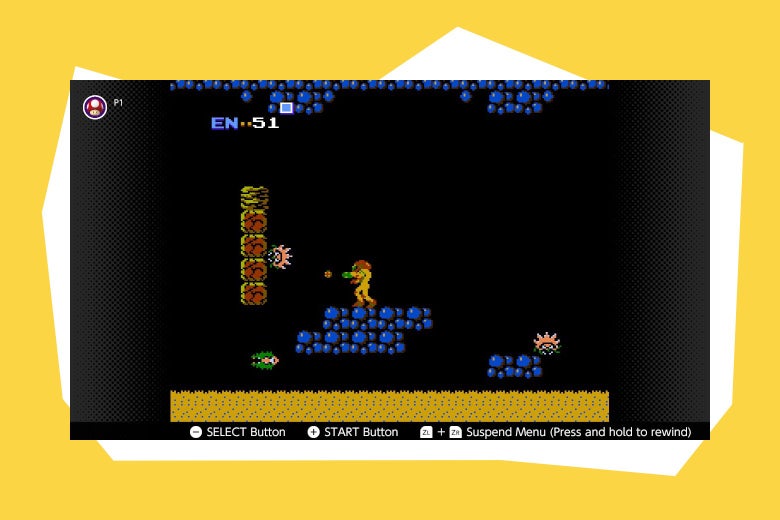
Photo illustration by Slate. Photo by Nintendo.
22. Metroid (Nintendo, 1987): The Metroid blueprint is there—the exploration, the backtracking, the upgrades that let you access new areas—but the actual map is not. The first Metroid has great music, a strong sense of place, and a diverse move set, but the world would have to wait for the Super Nintendo’s Super Metroid in 1994 for an in-game map, a key (pun intended!) ingredient in making the genre fun.
21. Double Dragon (Technos Japan, 1988): The seminal beat ’em up lets you punch bad guys off cliffs. It also had a memorable enemy design in the person of Abobo, whose huge pecs and even bigger head struck fear into toddler me.
20. NES Open Tournament Golf (Nintendo, 1991): The very first sports game starring Mario, this is kinda sorta an expanded rerelease of 1985’s Golf, with Mario and Luigi as golfers, Princess Toadstool and Daisy as caddies, and Donkey Kong as Mario’s accountant. How the mighty have fallen. The game has the same three-tap swing mechanic as modern golf games, and dang impressive putting graphics, but it’s hard not to miss the refinements found in, say, the Game Boy Advance’s Mario Golf: Advance Tour.
19. Shadow of the Ninja (Natsume, 1990): This appropriately titled Ninja Gaiden wannabe actually one-ups its inspiration on graphics and movement—the dynamic ceiling grabs make you feel more like a ninja than Ninja Gaiden’s static wall grabs—but doesn’t live up to its forebear’s sound quality and sheer personality. Think Peter Scolari playing the dad on Honey, I Shrunk the Kids: The TV Show instead of Rick Moranis.
18. Volleyball (Nintendo, 1987): In the words of Matthew 19:24, “It is easier for a camel to go through the eye of a needle than for you to score a point in 1987’s Volleyball for the NES.” Despite its lopsided difficulty, I’ll be coming back for more because of the game’s foosballsy control scheme, in which the D-pad moves an entire row of players at once, and the way everyone bows to one another between sets.
17. Star Soldier (Hudson Soft, 1989): If we were judging on music alone, this vertical-scroller would be this collection’s best shoot ’em up; on graphics alone, this would be the best; and on gameplay alone, this would be the best. It’s the best. Admittedly, the levels get repetitive, but you can’t blame the developers for sticking with something that works.
16. Zelda II: The Adventure of Link (Nintendo, 1988): The only game in the oeuvre of Shigeru Miyamoto that Nintendo’s creative powerhouse has admitted is kind of bad, Zelda II isn’t quite legendary. But you know what? I’ve always had a decent time with this side-scrolling black sheep of the Zelda series, with its comparatively intricate combat and linear structure.
15. City Connection (Jaleco, 1988): City Connection is the best argument for the Switch’s ability to rewind. It makes this otherwise frustrating, um, driving platformer, where you’re constantly running into roadblocks, other cars, and flag-waving cats, highly playable. The game’s main attraction, though, is an unrecognizably catchy rendition of Tchaikovsky’s Piano Concerto No. 1. (Here’s proof they’re the same piece of music.)
14. Balloon Fight (Nintendo, 1986): It’s a worse, later Joust. Still fun! Joust is a great game. And Balloon Fight has something Joust doesn’t: a huge horrifying fish that jumps up and swallows you if you hover too long near the water.
13. Ninja Gaiden (Tecmo, 1989): ”The name’s Ryu. Ryu Hayabusa.” This series’ between-level cut scenes are the most cinematic ever filmed in 8 bits. The action platforming is also tight, accompanied by sound effects that seem better than their underlying technology allows for. Who knew, though, that the true scourge of mystical ninjas aren’t demons and mercenaries but birds and bats?
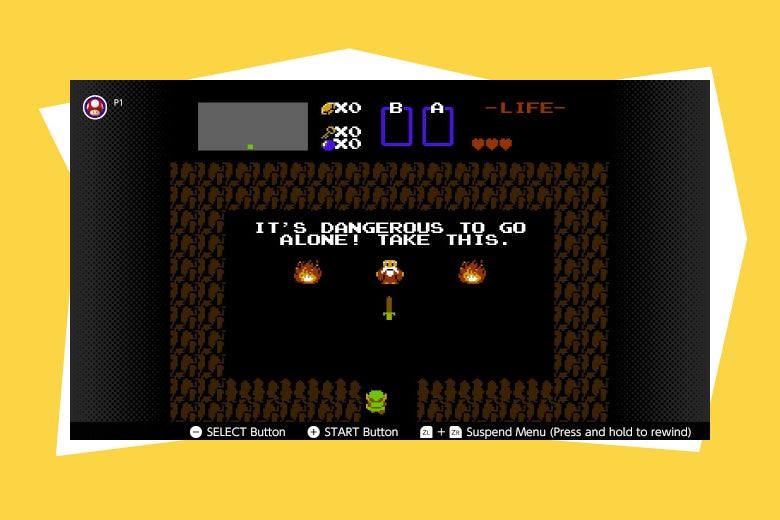
Photo illustration by Slate. Photo by Nintendo.
12. The Legend of Zelda (Nintendo, 1987): Inspired by Shigeru Miyamoto’s adventures in the caves and woods near his boyhood home in Japan, Link’s first outing is perhaps the most influential game of all time, opening the door to the freedom and exploration that have come to define the medium today. The first console game that allowed saving, Zelda took dedication to master (especially with a map that’s more like a radar screen) and contains a surprising number of elements of later games in the franchise, from instrument playing to those giant hands that fall from the ceiling. This is much more of an action game than the puzzle-filled, role-playing-ish adventures that came later, and this first title has an inverted difficulty curve, starting at its hardest when you have only three heart containers and a wooden sword. As the cornerstone of modern gaming, The Legend of Zelda is easy to admire. As a gaming experience today, though, it is tough to enjoy as much as other foundational titles, like Mario 1.
11. Donkey Kong (Nintendo, 1986): The only video game to ever make ladder climbing fun (though Metal Gear Solid 3 fans may disagree), Shigeru Miyamoto’s debut as a lead designer will forever be a key strand in gaming’s DNA. That said, the NES port has only three levels (the arcade version had four), which loop until you die, so the fun to be had here is in beating your own high score, not in gameplay variety.
10. Ice Hockey (Nintendo, 1988): By far the most charming sports game in this package, Ice Hockey is worth the price of admission for the Zamboni sequence alone. I rushed to play this game first of any in the Switch’s NES library, and it was even harder than I remembered: I kept accidentally passing the puck to the Soviets (I played as Czechoslovakia, abbreviated “TCH”); I was penalized for being part of a fight that I didn’t start; I lost 9 to 3; and I loved every minute of it.
9. Dr. Mario (Nintendo, 1990): One of the best non-Tetris puzzle games of all time.
8. Tecmo Bowl (Tecmo, 1989): Roger Ebert and I had the same reaction to Tecmo Bowl: “Interception?!” Passing is high-risk, high-reward, producing more turnovers than a bakery. Or go for a handoff—you get to pick plays, whether on offense or defense, which fosters all kinds of dumb little strategies. Sacking the quarterback feels as good as in any football video game of any era.
7. Kirby’s Adventure (HAL Laboratory, 1993): Kirby’s “backdrop” ability, where you suplex the ever-loving hell out of a poor little streetsweeper, might be the single most fun thing on the NES. This is the rare game in its library that can plausibly be beaten without cheating, despite its considerable length. I regret abusing the rewind function, which allowed me to beat the game with 64 lives.
6. River City Ransom (Technos Japan, 1990): Double Dragon except way better. You don’t arbitrarily drop weapons. You fight gangs with names like the Generic Dudes and the Frat Guys, whose members frequently accidentally hit one another and, when defeated, call out such phrases as “BARF!” And you can improve your character’s stats and move set with items from shops. I wish the shops told you what their dozens of high-priced consumables do—you have to eat a “Vita-Mint” or read a “Scandal Rag” to find out its effects—but no game is perfect.
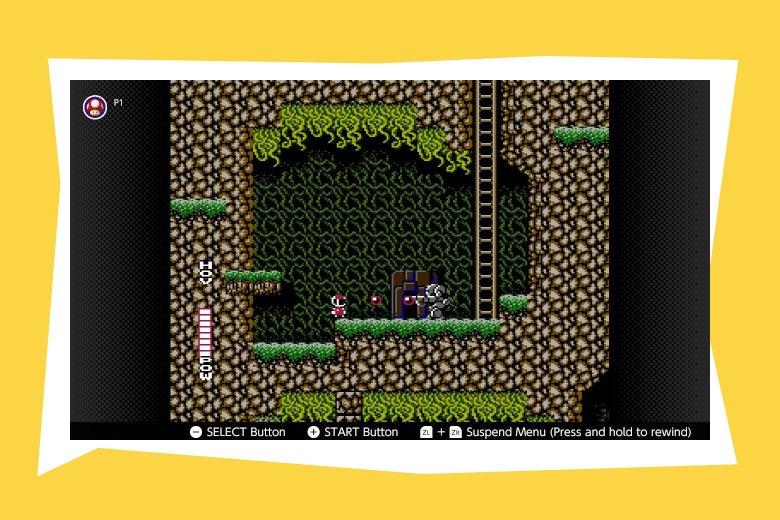
Photo illustration by Slate. Photos by Sunsoft.
5. Blaster Master (Sunsoft, 1988): A kitbash of two of the NES’s best games, Blaster Master has you hopping in and out of your vehicle to explore Metroid-style layouts, interspersed with dungeons viewed from above à la Zelda. The evocative, textless intro movie and the viney, dirty, dare I say Art Nouveau caverns, with roots hanging down from the ceiling, gave toddler me a fascination with the underworld that lasts to this day.
4. Super Mario Bros. (Nintendo, 1985): The arcade version of Donkey Kong was Mario maestro Shigeru Miyamoto’s breakout hit, but it’s Mario 1 that will forever be the default Nintendo game. Still a great starter game for kids, still a great choice for adults looking for a challenging, charming, nostalgic experience, set to Koji Kondo’s iconic score.
3. Super Mario Bros. 2 (Nintendo, 1988): Mario 2 takes place in Subcon—Mario’s subconscious—a dreamworld where enemies wear masks and you defeat them with root vegetables plucked out of the desert sand. The best of Weird Nintendo, Mario 2 started out as a non-Mario game and was reskinned as such for the West. Fun fact: In Japan, where the “real” Super Mario Bros. 2—what Westerners know as The Lost Levels—was released, this game is known as Super Mario USA. Though its development had little to do with America, the game’s ragtime-y overworld theme and feminist allocation of the best moves to playable character Princess Toadstool make me feel patriotic.
2. Punch-Out!! (Nintendo, 1990): Punch-Out!! earns its second exclamation point. It has the most memorable art in the NES library, from the exaggerated Kabuki stylings of Piston Honda’s I’ve-just-been-punched face to the gorgeous multiplane side-scrolling of the training sequence that plays every few bouts. The gameplay, in which opponents are at their most vulnerable in the split second before they do their finishing moves, overflows with personality. Punch-Out!! is also just plain odd, in a way video games aren’t really anymore. Between rounds in the brutal fight against Mr. Sandman, protagonist Little Mac pleads with his trainer, “Help! Doc!!” Doc responds, “Join the Nintendo Fun Club today!”
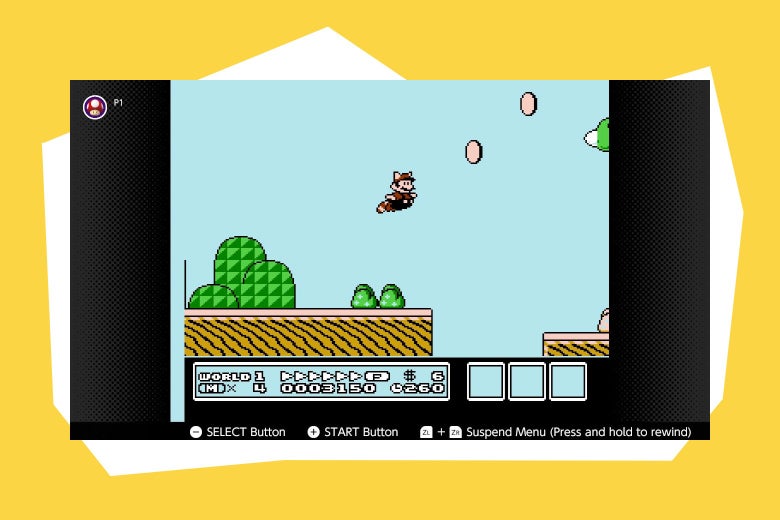
Photo illustration by Slate. Photo by Nintendo.
1. Super Mario Bros. 3 (Nintendo, 1990): Surprise! The best game on the NES is the best game in the Switch’s NES collection. The Super Nintendo’s Super Mario World and its sequel, Yoshi’s Island, might play better today, but there’s a reason this game will always be so many Nintendo fans’ favorite 2D Mario. A perfect mashup of Weird Nintendo and Ingenious Nintendo, Mario 3 is full of wonders and oddities, like the first-level secret that lets you run in the background of the stage, the rulebreaking-ly giant enemies of World 4, the boot-suit riot of World 5, and, of course, slipping the surly bonds of the Mushroom Kingdom with the flight-enabling raccoon suit. Do yourself a favor and don’t use any of the warp whistles to skip levels. This is a game that deserves to be experienced in its entirety.
Future Tense
is a partnership of
Slate,
New America, and
Arizona State University
that examines emerging technologies, public policy, and society.



